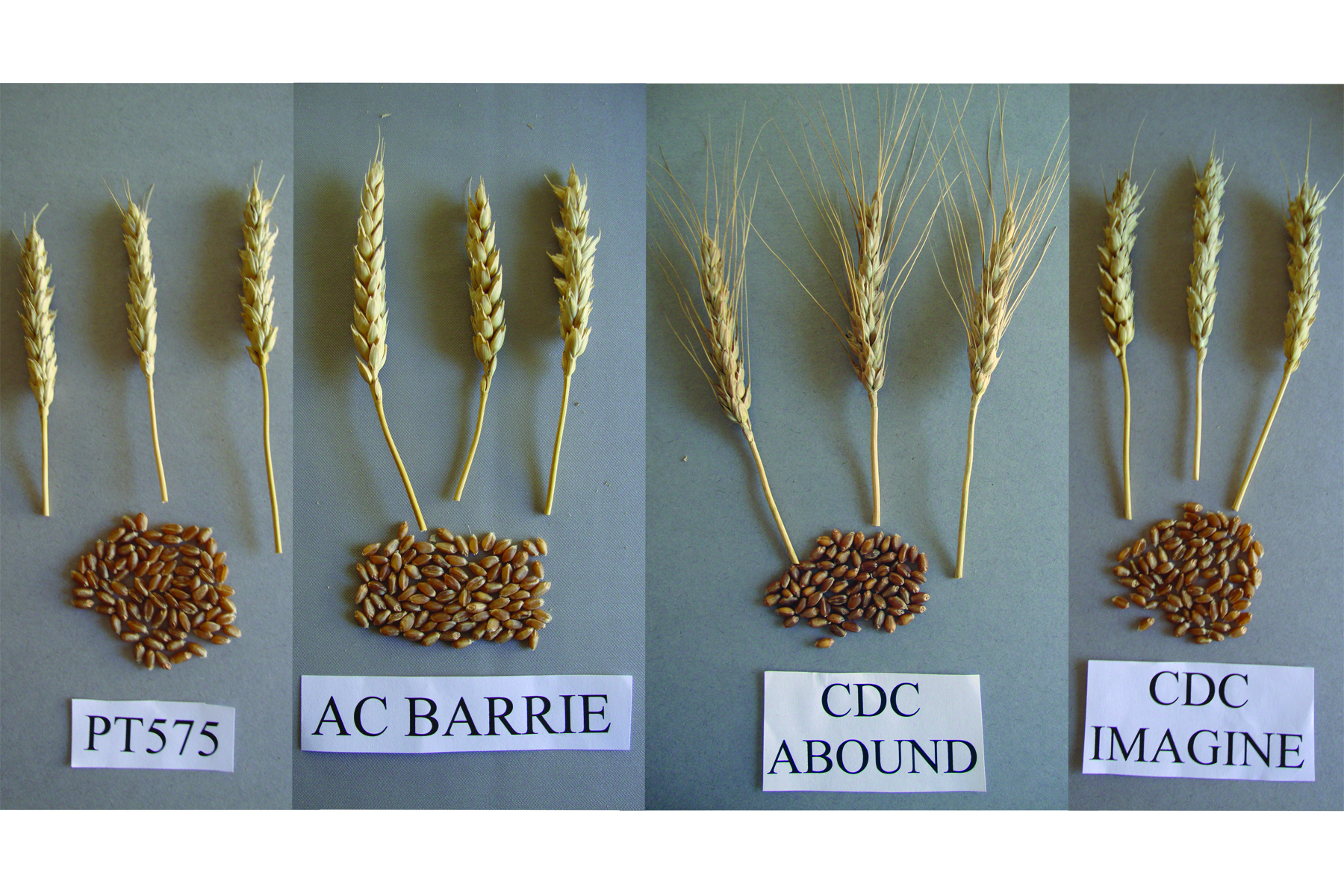CDC Thrive
| Denomination: | 'CDC Thrive' |
|---|---|
| Previously Proposed Denomination: | 'PT575' |
| Botanical Name: | Triticum aestivum |
| Applicant/Holder: |
University of Saskatchewan Crop Development Centre 4D36 Agriculture Building, 51 Campus Drive Saskatoon, Saskatchewan S7N 5A8 Canada |
| Breeder: |
Pierre Hucl, University of Saskatchewan, Saskatoon, Saskatchewan |
| Agent in Canada: |
Cargill Limited 300-240 Graham Avenue Winnipeg, Manitoba R3C 4C5 Canada Tel: 204-947-6319 |
| Application Date: | 2009-06-02 |
| Application Number: | 09-6654 |
| Grant of Rights Date: | 2012-11-05 |
| Certificate Number: | 4425 |
| Date rights surrendered: | 2020-11-05 |
Variety Description
Varieties used for comparison: 'AC Barrie', 'CDC Imagine' and 'CDC Abound'
Summary: The flag leaves of 'CDC Thrive' are pubescent on the blade and glabrous on the sheaths whereas the flag leaves of 'CDC Imagine' and 'CDC Abound' have glabrous blades and pubescent sheaths. The plants of 'CDC Thrive' are taller than those of the reference varieties. The spike of 'CDC Thrive' has tip awnlets whereas 'CDC Abound' has awns. 'CDC Thrive' is resistant to the herbicide, imidazolinone, whereas 'AC Barrie' is susceptible.
Description:
PLANT: common spring wheat, matures mid-season, erect growth habit, low frequency of recurved flag leaves
SEEDLING (4-leaf stage): absent or very weak intensity of anthocyanin colouration of the coleoptile, glabrous sheath and blade of the lower leaves
FLAG LEAF: very weak anthocyanin colouration of the auricles, medium to strong glaucosity of the sheath, pubescent blade and glabrous sheath
CULM/NECK: weak to medium glaucosity, straight at maturity
SPIKE: weak to medium glaucosity, parallel sided, medium density, white at maturity, erect attitude at maturity, sparse hairiness of the convex surface of the apical rachis segment
AWNS: tip awnlets present, short
LOWER GLUME: medium width shoulder, slightly sloping shoulder shape, medium width and length, glabrous, short straight to slightly curved beak, sparse extent of internal hairs
LEMMA: straight beak
STRAW AT MATURITY: thin in cross section, no anthocyanin colouration at maturity
KERNEL: hard red, medium red, medium size, medium length and width, oval, angular cheek, short brush hairs, medium sized oval germ, narrow shallow crease, dark colouration with phenol
AGRONOMIC CHARACTERISTICS: resistant to imidazolinone herbicide
Origin & Breeding History: 'CDC Thrive' (experimental name 'PT575') was selected from the cross 'CDC Bounty' / 'CDC Imagine' made in 1999 at the Crop Development Centre, Saskatoon, Saskatchewan. The F1 was grown in a greenhouse during the winter of 1999. The F2 was bulked in Saskatoon in 2000 with the F3 bulked in a winter nursery. The F4 was sown in bulk in Saskatoon in 2001. Seed from single-plant selections were grown out for the F5 and F6 in a rust nursery in Saskatoon and selections were made based on rust reaction, plant type, straw strength and yield. 'PT575' was evaluated as IR04031 in preliminary yield trials in 2004, in the Western Bread Wheat B Test in 2005 and subsequently evaluated in the Parkland Wheat Cooperative Test from 2006 to 2008.
Tests & Trials: Tests and trials were conducted during the summers of 2009 and 2010 at the Crop Science Field Laboratory of the Crop Development Centre in Saskatoon, Saskatchewan. Plots consisted of 5 rows with a row length of 3.6 meters and a row spacing of 23 cm. There were 4 replications arranged in an RCB design.
Comparison tables for 'CDC Thrive' with reference varieties 'AC Barrie', 'CDC Imagine' and 'CDC Abound'
Days to heading
| 'CDC Thrive' | 'AC Barrie' | 'CDC Imagine' | 'CDC Abound' | |
|---|---|---|---|---|
| mean | 62 | 60 | 63 | 63 |
Plant height (cm)
| 'CDC Thrive' | 'AC Barrie' | 'CDC Imagine' | 'CDC Abound' | |
|---|---|---|---|---|
| mean 2009 | 101.75 | 96.7 | 93.7 | 87.4 |
| std. deviation | 4.91 | 2.92 | 3.13 | 3.90 |
| mean 2010 | 90.10 | 85.95 | 84.30 | 82.25 |
| std. deviation | 4.23 | 2.21 | 3.44 | 3.29 |
Click on image for larger view

Wheat: 'CDC Thrive' (PT575) (left) with reference varieties 'AC Barrie' (centre left), 'CDC Abound' (centre right) and 'CDC Imagine' (right)
- Date modified: